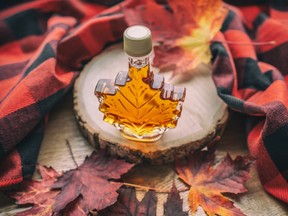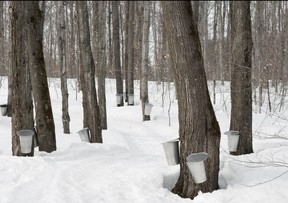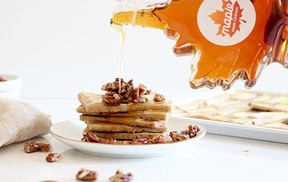Let the sap flow as Canadians continue their love affair with maple syrup

Reviews and recommendations are unbiased and products are independently selected. Postmedia may earn an affiliate commission from purchases made through links on this page.
Article content
Canadians are just a bunch of saps when it comes to loving maple syrup. This iconic food is imbedded in the country’s national identity, a liquid gold that flows from sea to shining sea – even our flag proudly displays a red maple leaf.
Advertisement 2
Article content
Research shows Canada’s the world leading producer and exporter of maple products, and, according to Statistics Canada, the Canadian maple syrup industry accounts for about 71% of the world’s maple syrup production, with puremaplefromcanada.com reporting that 91% of Canada’s syrup production comes from Quebec, whose annual production is around 7,989,000 gallons – making it the largest producer of maple syrup globally.
Article content
Today, Canadian maple syrup is exported to more than 50 countries, including the U.S.
According to the International Maple Syrup Institute, “pure maple syrup is a unique and natural product produced exclusively by the concentration of sap from the maple tree.”
It’s a natural sweetener that contains no added sugar, colouring agents, artificial flavourings, preservatives or other additives, and is a wonderful source of important nutrients and vitamins when compared to other sweeteners, notes the nonprofit organization, founded in 1975 to promote and protect pure maple syrup and other pure maple products.
Advertisement 3
Article content
Historically, maple syrup dates back centuries to the Indigenous peoples who were tapping maple trees for sap long before the arrival of European settlers. And while the early settlers learned to make maple syrup, it wasn’t until the 19th century, when metal containers were used to catch and boil the sap, that it became a significant industry.
How’s it made? With plenty of patience – in the simplest explanation, basically, maple trees are tapped in early spring (while frost is still in the ground) for the tree’s sweet sap, which is then boiled down into syrup. The rest, as they say, is history!

CANADIAN NATIONAL SYRUP DAY
Is coming up December 17, a special day to honour this special syrup. The sweet and sticky ingredient is so heavily ingrained in the Canadian identity that the rest of the world automatically associates it with the Great White North notes the Time2Play gambling website in a media release, offering a recent country-wide look at just how much maple syrup is consumed across the land, and how much Canadians love it.
Advertisement 4
Article content
Turns out out 89.7% Canadians love the sticky sap!
How much? According to Time2Play:
– Quebec consumes the most maple syrup – eating it 7.8 times a month on average
– Saskatchewan comes in at an impressive 5.0 times a month on average
– Manitoba consumes the least amount of maple syrup – eating it 3.4 times a month on average
– Ontario consumes 4.7 times a month on average
– New Brunswick comes in at 4.5, with Alberta coming in at 3.7 and British Columbia at 3.8.
– Saskatchewan is the only province that pairs maple syrup with waffles, while all others prefer pancakes
– Only 10.3% of Canadians don’t consume maple syrup due to taste, substitutes, and dietary restrictions
Pancakes vs. Waffles vs. French Toast
“As 89.7% of our respondents say they’ve consumed maple syrup this past year, we asked the controversial question: What does your household typically pair maple syrup with?” said Time2Play’s Rhiannon O’Donohoe.
Advertisement 5
Article content
“Nationwide, every province and territory is team pancakes except for one province – Saskatchewan. The landlocked province prefers to pair maple syrup with waffles despite what the rest of the nation thinks.”
On a more individual level, said O’Donohoe on a media release, “over half (55.2%) of the respondents pair maple syrup with pancakes, while 20.4% pour syrup on waffles. French toast lovers only account for 11.2% of the data, while others (13.2%) use maple syrup as a cooking ingredient for sauces, potato dishes, baking, etc.”
(The Northwest Territories, Nunavut, and Prince Edward Island were not accounted for due to a lack of data.)
– Time2Play
Colour and Grading
According to Foodland Ontario, maple syrup grades are based on clarity and flavour characteristics, and, depending on where it is produced, either federal or provincial grade standards may be used.
Advertisement 6
Article content
All maple syrup is colour classified as:
Golden (with a delicate taste),
Amber (with a rich taste),
Dark (robust), or Very Dark (strong).
Nutritionally, 1 Tbsp. (15 mL) contains about 40 calories.

Apple Maple Pecan Sheet Pan Pancakes
Recipe courtesy of puremaplefromcanada.com.
Pancakes
2 eggs
1 cup unsweetened vanilla almond milk
3/4 cup cassava flour
3/4 cup blanched almond flour
1 tsp. baking powder
1/2 tsp. cinnamon
1/2 tsp. ginger powder
1/2 tsp. ground cloves
1 Tbsp. unrefined coconut oil
Toppings
1 apple
1 cup pecans
2 Tbsp. pure maple syrup
1 tsp. cinnamon
Drizzle of additional pure maple syrup
Preheat the oven to 400F. Meanwhile, add all pancake ingredients (except coconut oil) into a blender and blend for 30 seconds. Add one tablespoon of unrefined coconut oil to a baking sheet. Pour batter onto baking sheet, add thin slices of apple on top and bake in oven for 5-8 minutes.
While the pancake bakes, in a non-stick sauté pan on medium low, add maple syrup and pecans and stir often for 3-5 minutes.
When pancakes have finished baking, top with maple pecans and serve. Add additional drizzle of maple syrup.
For more latest Food & Drinks News Click Here


